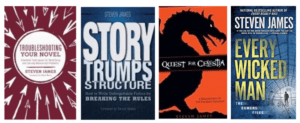by Steven James

Picture a snowball rolling down a mountain.
Picking up speed.
Gaining momentum.
Eventually becoming an avalanche.
As it travels along, it grows in magnitude, just like the tension of your story will do.
The narrative momentum of the promises you make early in the book will continue to build, creating endings that tumult into unforgettable climaxes. Tension will tighten, complications will arise. Unavoidable detours will crop up.
The snowball is going to smack into something at the bottom of that mountain. It’s not just going to quietly roll to a stop.
Stop thinking of a story in terms of something that has “a beginning, a middle, and an end.” Of course, it does. That’s obvious. Everything has a beginning, a middle, and an end. Instead, think of the story as a progression of increasingly difficult setbacks that escalate the tension until it reaches a satisfying conclusion, regardless of the number of acts that might require.
In a story, every moment is a point of no return.
Fixing Escalation Issues
Escalation isn’t about the number of things that go wrong; it’s about the depth and force of that specific avalanche on that specific mountain.
So, identify your mountain, get things rolling, and escalate the avalanche. Here’s how:
- Promise early that an avalanche might occur. Use implied and explicit promises that this story will move in the direction of a potential avalanche. The avalanche shouldn’t come out of nowhere. As early as possible in your story, show how precariously the snow is perched on that mountain.
- Start small; get big. It seems obvious, but if you start with the avalanche, how will you escalate from there? Don’t insert too much tension in your hook or your opening or you won’t have anywhere to go and the story’s tension will deescalate. Stories aren’t about sustained conflict; they’re about escalating struggles. Let your characters’ struggles grow.
- Show readers the village at the base of the mountain. Make the danger more imminent and the devastation increasingly unavoidable. You’ll create even more tension if you allow readers to see the avalanche, but for the time being, keep the villagers oblivious to the danger.
- Stay on one mountain. Don’t just add random setbacks. Deepen your protagonist’s primary struggle—the one that was introduced at the beginning of the story and revolves around his central pursuit.
- Include some skiers trying to outrun the avalanche. When you put more characters in peril, or bring the danger closer to the people you’ve already introduced in the story, you’ll escalate the tension. Show the skiers early in the story, heading up the mountain to avoid the book seeming contrived when they’re put in danger later on.
- Let the villagers try to solve things, but fail. Maybe they attempt to reroute the snow, but it doesn’t work. Maybe they try to flee, but the bridge collapses. Everything they try will either fail or make things worse.
- Steepen the slope. Guess what? Things are worse than the villagers thought. When that one section of the mountain gave way, the avalanche picked up even more speed. Repetition undermines escalation, so make sure that events progress exponentially rather than steadily. Eliminate repetition. Let things keep getting worse.
- Throw in a blizzard. Why not? Foreshadow that the storm is rolling in, and then reveal the rising helplessness and hopelessness of those poor, stranded villagers.
Often, writers fail to provide variety and escalation of emotion. For example, a character is always yelling or always pounding the table or whining or gasping or sighing or crying. Instead, have the character express escalating emotion to show how things are continuing to get worse.
Take your protagonist, for example. In a notebook, list three ways he could show anger, impatience, or jealousy in escalation.
How much escalation do I need?
As much as believably possible.
Quick fix: If a scene is stalling out, go back earlier in the book and promise pain or danger, and then remind readers of how close that danger is right now. Insert an obstacle the characters must avoid, but by doing so they end up closer to the brink. Verify that each scene contains an appropriate sense of urgency based on the context, the pursuit, and the current timeframe.
As you get closer to the climax, include shorter paragraphs and sentences, and avoid unfamiliar words that might trip up readers.
Fine-Tuning My Manuscript
- Have I succeeded in bringing the danger closer and closer, sharpened the promises of peril, and clarified the consequences and stakes?
- As the story builds toward its climax, have I focused more on tightening the tension than on rising action? Have I mistaken movement or action for escalation? How can I include less action but imbue it with more meaning, using fewer events but giving them more narrative significance?
- As the tension escalates, have I made things personal for the protagonist?
- Is the escalation undercut by too much repetition? Where do I have similar events (chase scenes, murders, etc.) that don’t escalate? How can I eliminate some or ratchet up the tension, danger, or stakes of others as they build toward the climax?
- Is the unmet desire of the characters clear in each scene? How can I add more complications to drive the story forward?
- Do the struggles intensify as the main character tries to solve her problem and fails, scene by scene, until she either achieves her goal (or fails to achieve it) in a way that is unexpected and inevitable?
 Steven James is the critically acclaimed, national best-selling author of 16 novels. With a master’s degree in storytelling, he has taught writing around the world. His work has been optioned by ABC Studios and praised by Publishers Weekly, Library Journal, The New York Journal of Books, and many others. He’s a contributing editor at Writer’s Digest magazine and the author of the groundbreaking book Story Trumps Structure and the guidebook used by thousands of novelists, Troubleshooting Your Novel, both from Writer’s Digest Books.
Steven James is the critically acclaimed, national best-selling author of 16 novels. With a master’s degree in storytelling, he has taught writing around the world. His work has been optioned by ABC Studios and praised by Publishers Weekly, Library Journal, The New York Journal of Books, and many others. He’s a contributing editor at Writer’s Digest magazine and the author of the groundbreaking book Story Trumps Structure and the guidebook used by thousands of novelists, Troubleshooting Your Novel, both from Writer’s Digest Books.
Steven will teach a six-hour Early Bird seminar, “Troubleshooting Your Novel: Essential Techniques for Identifying and Solving Manuscript Problems,” Monday, August 12 from 9:00 a.m.–3:00 p.m. (Registration details here. Lunch is included.)
Steven will also teach a seven-hour coaching class, “Suspense Essentials: Secrets to Tapping into Tension Whatever Genre You Write,” during the Oregon Christian Writers Summer Conference August 12–15 in Portland.








